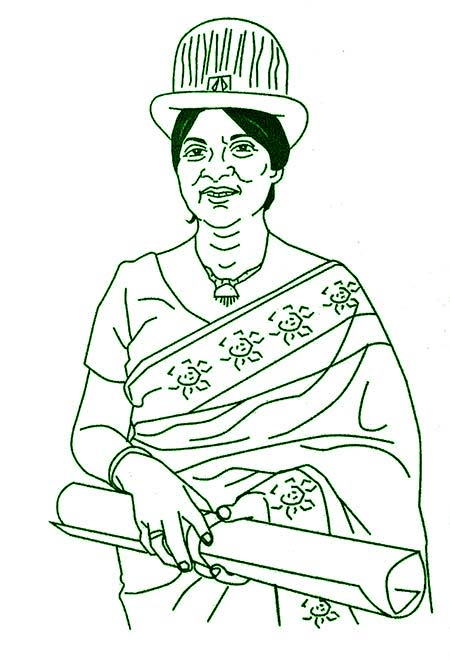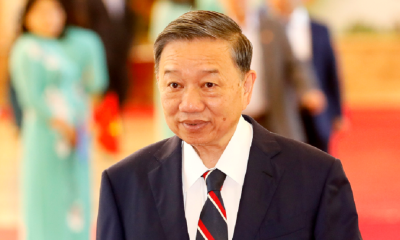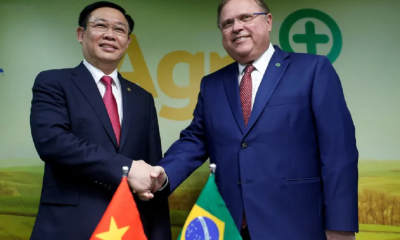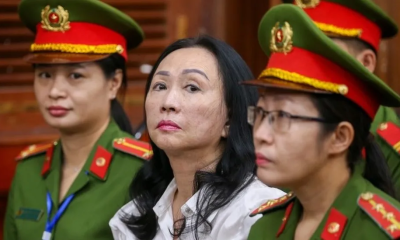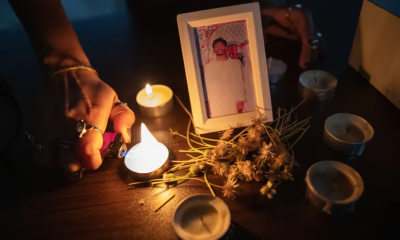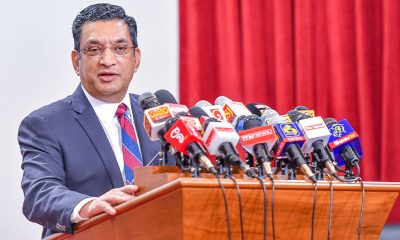Features
My doctorate in medicine, honoris causa, from the University of Uppsala, Sweden
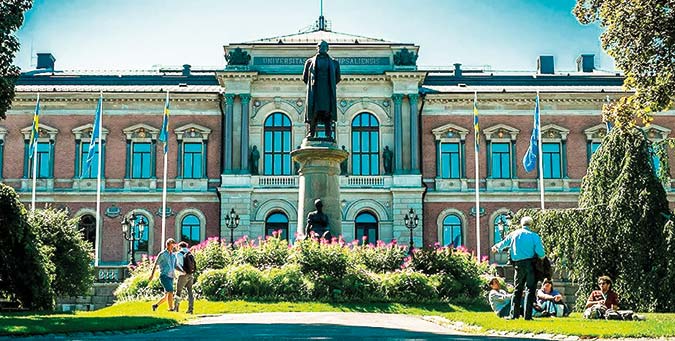
(Excerpted from Memories that Linger: My journey through the world of disability
by Padmani Mendis)
With their experience in Vietnam, Radda Barnen (RB) then included childhood disability and CBR (Community Based Rehabilitation) in many of their other country programmes. Soon after their own tragedy under Pol Pot, I was in Cambodia next door; then across to Yemen, first the two Yemens which were divided as north and south and then again after it was united as one; also to Guinea Bissau and the Cape Verde islands in Africa. For Afghan professionals working in disability we conducted frequent courses in Peshawar, Pakistan. International workers did not go into Afghanistan for any length of time in those days.
For all these years of guidance and companionship I enjoyed from Kristina Fenno, she is forever remembered. Kristina was Sweden’s former Children’s Ombudsman. Now still using her love of children everywhere, she was at Radda Barnen part time. She once said to me, “Padmani, I join you whenever I can because every time I do I learn something new.” One of the greatest compliments I have ever had, and this from an outstanding lady.
Meeting disabled people in all these countries was my good fortune. Working with Radda Barnen was an important part of that. Which took me often to Sweden and to my great good fortune to know the Swedish people, to learn from them and I believe, to have been loved by them.
International Child Health Unit, Uppsala University, Sweden
I was carrying out my first task for Radda Barnen and located at the Provincial People’s Committee Meeting Complex in My Tho, the capital city of Vietnam’s Tieng Giang province. The course was to increase the capacity of mid-level workers in the health system to carry out tasks in CBR. We had planned it to be a one-month long course. Mid-level workers included assistant doctors, nurses, Red Cross workers and others. With a maximum three-years of basic training. This I think was the first exposure the provincial health system at this level had to any international support.
And so, this was the first such learning experience for these participants, and they were enjoying it. They responded unexpectedly to my learner-centred teaching methodology. The workshop atmosphere was relaxed and intensively participatory, the sessions a continuous interactive dialogue. All of us enjoyed learning through debate and discussion. Such a different teaching-learning experience from the formal lecture-based one I had in the People’s Republic of China. But which I had also enjoyed in a very different way.
My national counterpart and interpreter through my many years of work for RB in Vietnam (VN) was Dr. Tran Trong Hai. His own relaxed approach to teaching and his sense of humour added to the whole experience for all. Dr. Hai was, incidentally, a Consultant in Childhood Disability. He was the Director of the Rehabilitation Department at the Olaf Palme Institute for Children in Hanoi, the only such specialised hospital in the country.
Dr. Hai’s boss in Hanoi was Prof. Nguyen Thu Nhan, the director of the hospital. Her support enabled CBR to grow rapidly in VN. Olaf Palme was the Swedish Prime Minister I mentioned earlier in this section. It was in this context that he recognised VN soon after her victory over the Americans. With diplomatic relations established and an agreement on what was then called “Aid”, and now called “Development Cooperation”. Sweden was only country to do this at that time.
Prof. Yngve Hofvander
With contribution from Dr. Hai’s unending store of tall stories and jokes there was much fun and laughter in the classroom. At times excessively loud. I was conscious that another teaching course had started that day about a week after ours on the floor beneath us, but not what it was about. Until, as we closed for that day, a stranger came hastily up the stairs to talk with me. He was tall, well-built and both light-skinned and light-haired. Hard to say blond; obviously a Swede.
This is how I met Professor Yngve Hofvander, Head of International Child Health or ICH of Uppsala University, Sweden. The second Viking to have a strong influence in changing the course of my life. The first was of course Einar Helander. Hofvander had inquired from the health people what was happening upstairs with all that noise. Being told it was someone from Sweden he came as soon as he could to meet me.
I had first to tell him all about what I was doing and who I was. And then I found out that he himself was teaching a group of Primary Health Care doctors about neo-natal care and the importance of breastfeeding in infancy. This was, I found out later, an area of health for which he was known the world over. He had been to the local market that afternoon with his group to look for tools such as weighing scales and other instruments they could adapt and use for monitoring the growth of babies.
He was in My Tho for only two days. We spent both evenings together. Saying, “there was so much to talk about,” is too obvious. One significant question he had for me related to the fact that his staff in Uppsala had suggested that the International Child Health Unit initiate international education on CBR for professionals. Being colleagues, he had talked about it with Einar. And what did I think about it? You know what my answer was.
From Vietnam to Uppsala University, Sweden
So it was one November soon after, I was myself at the ICH, at Uppsala University, as the principal resource person on a course called “International Course on Disability in Developing Countries”. And I continued to be invited for it, I think, for a period of eight or nine years. My module called “CBR” was usually four days and the longest on the course.
Each course module was carefully evaluated. And for the best evaluation on each course, I had a competitor, a senior Swedish medical teacher at the ICH. When I received the evaluation by post each year, my most urgent task was to compare our two evaluations. And happy I am to say that I was seldom disappointed.
Every course had participants from Scandinavian countries as well as from some developing ones. These countries were some that I had been to before and could reference. In a few instances participants had their sponsors invite me to visit them later.
It was in this way that Tarja Ihamaki had the Evangelical Lutheran Church of Finland invite me to Namibia on two occasions. Once to introduce CBR and the other to carry out a holistic evaluation of their disability work.
Doctor of Medicine, Honoris Causa
One year, it was probably 1989, while I was carrying out my teaching module, I noticed that at regular intervals, various ICH staff members would come in to sit quietly as observers at the back of the lecture room. This was obviously deliberate. I took no notice of it. Well, I had no other choice really. Three months or so later I knew what it had been about. The staff were, in their own way, assessing me. Assessing my suitability for something very, very special – a recommendation they would make to Uppsala University through the Faculty of Medicine.
In May 1990 Uppsala University awarded me a Doctorate in Medicine, Honoris Causa, In recognition of my contribution to the global development of CBR as a strategy for the upliftment of the quality of life of disabled people in developing countries. This was beyond my wildest expectations. To me it was recognition of CBR from a global academic leader renowned for its search for scientific knowledge. I came to know later that Alfred Nobel too received an honorary doctorate from the same university just over a hundred years before me.
Uppsala University invited me to the convocation to be held on June 01, 1990. Yngve was my formal host on behalf of the University. I was to be in Uppsala for three days and he had the task of arranging a programme for me. He asked me what I would like to do. I said, could I please visit Linkoping University. I had read about the work they were pioneering in problem-based learning. Later I adapted what I learned there to my own teaching in CBR.
The Convocation
June 1st was a Friday. It was shortly before seven in the morning and there we were, a happy group sitting on the grassy hillside of Uppsala Castle. Overlooking the Linnaeus Botanical Gardens. A tradition observed by Yngve and his lovely wife Ruth-Marie was that, whenever they had someone associated with the ICH being given a special award like this, they hosted breakfast on the grounds of Uppsala Castle.
Yngve and Ruth-Marie had invited all the ICH staff. Also those who knew me from Radda Barnen in Stockholm. So there we were a group of around 20 or so. Ruth-Marie was a specialist and a teacher of cookery. She had prepared the most delicious Swedish open sandwiches and other finger foods. Served with piping hot coffee. Partaken over conversation and camaraderie at a joyous get together. On the morning of a very special day for me – the convocation. I was to become an Honorary Doctor.
But why were we here so early in the morning? Because when the Uppsala Cathedral clock struck seven, the two huge guns placed on the castle grounds would fire their cannon. One canon for each person who the University would make an Honorary Doctor that day. We had come to the castle grounds to listen to the canon that was fired for me. Later that morning a second canon would be fired for me. I’ll come to that soon.
By elevev that morning I was dressed and ready for the vehicle that would take me to the University. For the occasion, my sister-in-law Sita had helped me choose a silk saree in peacock blue with a striking broad pink and silver border and pallu. This was the most I had spent for a saree in the 51 years of my life until then – five thousand rupees.
As well as from Uppsala, the other honorary doctors were from the universities of Yale, New York, Cornell, Berkeley (California), Oxford, Manchester, Berlin, Osaka and Linkoping. Together with the would-be honorary doctors, special guests and university dignitaries, I was waiting in a large hall on the ground floor of what was called quite simply the “University Building”. It dated back to 1877. Seemed to be based on Greek architectural style, both the exterior and interior were magnificent. Corridor roofs and that of each room were a series of high domes supported by elaborate pillars rounding off at the top to extend their support to the domes. Everywhere from the dome to the floor was covered with statues, portraits, paintings, sculptures and carvings, many of the most intricate design.
Within this continuing magnificence, at 11.45 sharp we were taken in procession along a winding staircase to what is called the Aula or Auditorium. In China what would be called the Great Hall.
Leading us were flag bearers in colourful Swedish traditional dress, both young women and men students. Some carried flags of the university, others carried flags representing the Swedish provinces from whence they came. We, the special ones followed the Vice Chancellor with the university dignitaries following. Up the winding stairs we went and to our seats on the dais. And all this to the sound of resounding music. I feel the exuberance that overwhelmed me as if it was yesterday.
Events on Mount Parnassus
While on the dais, we first stood to the National Anthem and tribute to King Carl Gustav VI of Sweden who was the Chancellor of this prestigious university. This was followed by speeches – in the Swedish style, very brief. Soon it was my turn. My name was called by the Vice Chancellor.
I stood up and he read out my citation. He invited me to the podium. I moved forward recalling that I was to climb Mount Parnassus, the Greek Mount of Learning which was symbolised by the podium. And as I climbed up, the Vice Chancellor, standing at the mountain top extended to me his hand to symbolically help me up. At the same time saying, “Welcome, Mrs. Mendis.”
First, on my head he placed the traditional hat from the Faculty of Medicine symbolising freedom and power. And as he placed the hat on my head my second canon was fired from the Castle grounds. We heard it as close and as significantly as if it were outside the window.
Then on my ring finger he placed the doctoral ring of gold, symbolising faithfulness towards science and scholarship. The ring has engraved on its inside my name and the date of the convocation, and encircling it on the outside is the rod of Aesculapius, the Greek God of Medicine and son of Apollo.
To my hand he gave me an elaborate certificate of conferment. It confirms the rights that are due to doctoral graduates.
Thereafter, taking my hand again, he turned me around and saying, “Farwell Honorary Doctora Mendis,” he moved me to the steps. I came down from Mount Parnassus. An Honorary Doctor of Medicine of the University of Uppsala, Sweden.
More conferments followed, including that of doctoral degrees to Faculty Members. And then the Exit Ceremony, as elaborate as the one that brought us in. With the music as resounding. That anything Swedish based on their culture would be so full of colour, of tradition and of symbolism was a complete surprise to me. I had thought of the Swedes as being somewhat staid and matter-of-fact until I got to know them. They are sensitive, gentle giants filled with empathy and warmth and a concern for sharing.
And sentimental as I am, my two canon shells sit atop an antique cupboard, while the certificate is framed in one to match it and hangs on the wall nearby. Both positioned subtly but still to be seen by any visitor to my home. The hat is safe in my wardrobe and taken out once in a while, when I need strength. The ring on my finger is a constant reminder of all that I need to be reminded about.
The end of a Special Day
This was not the end of the ceremonies. A gala banquet followed in the evening and was held inside the castle. Hosted by the university. It was Yngve and Ruth-Marie who took me there. It was of course a white tie, tails and white waistcoat affair with the many who had decorations displaying them on their coats or round their necks. In spite of speeches and numerous toasts the evening came to an end all too soon.
There were two individuals who were constantly in my thoughts all through that special day. One, Gunnel – I missed her so. We would have shared the joy of the event together. And the other, Einar of course. It was he who started it all. In Solo, Indonesia, when we first met in December 1978. Now, in 1990 when he heard about my award he wrote, “You have got this only because you earned it… You have worked in a very low-status area and one in which prizes are seldom received.” Einar was particularly pleased because Uppsala was his Alma Mater. Through me, he had come full circle.
And with that must my memories of that day end.
Features
The heart-friendly health minister
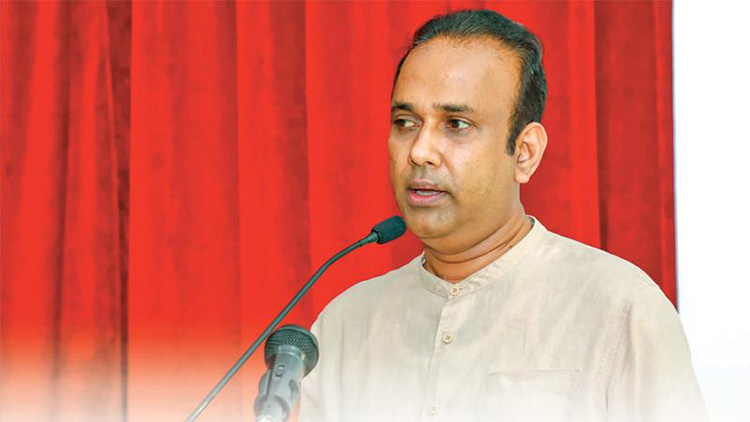
by Dr Gotabhya Ranasinghe
Senior Consultant Cardiologist
National Hospital Sri Lanka
When we sought a meeting with Hon Dr. Ramesh Pathirana, Minister of Health, he graciously cleared his busy schedule to accommodate us. Renowned for his attentive listening and deep understanding, Minister Pathirana is dedicated to advancing the health sector. His openness and transparency exemplify the qualities of an exemplary politician and minister.
Dr. Palitha Mahipala, the current Health Secretary, demonstrates both commendable enthusiasm and unwavering support. This combination of attributes makes him a highly compatible colleague for the esteemed Minister of Health.
Our discussion centered on a project that has been in the works for the past 30 years, one that no other minister had managed to advance.
Minister Pathirana, however, recognized the project’s significance and its potential to revolutionize care for heart patients.
The project involves the construction of a state-of-the-art facility at the premises of the National Hospital Colombo. The project’s location within the premises of the National Hospital underscores its importance and relevance to the healthcare infrastructure of the nation.
This facility will include a cardiology building and a tertiary care center, equipped with the latest technology to handle and treat all types of heart-related conditions and surgeries.
Securing funding was a major milestone for this initiative. Minister Pathirana successfully obtained approval for a $40 billion loan from the Asian Development Bank. With the funding in place, the foundation stone is scheduled to be laid in September this year, and construction will begin in January 2025.
This project guarantees a consistent and uninterrupted supply of stents and related medications for heart patients. As a result, patients will have timely access to essential medical supplies during their treatment and recovery. By securing these critical resources, the project aims to enhance patient outcomes, minimize treatment delays, and maintain the highest standards of cardiac care.
Upon its fruition, this monumental building will serve as a beacon of hope and healing, symbolizing the unwavering dedication to improving patient outcomes and fostering a healthier society.We anticipate a future marked by significant progress and positive outcomes in Sri Lanka’s cardiovascular treatment landscape within the foreseeable timeframe.
Features
A LOVING TRIBUTE TO JESUIT FR. ALOYSIUS PIERIS ON HIS 90th BIRTHDAY

by Fr. Emmanuel Fernando, OMI
Jesuit Fr. Aloysius Pieris (affectionately called Fr. Aloy) celebrated his 90th birthday on April 9, 2024 and I, as the editor of our Oblate Journal, THE MISSIONARY OBLATE had gone to press by that time. Immediately I decided to publish an article, appreciating the untiring selfless services he continues to offer for inter-Faith dialogue, the renewal of the Catholic Church, his concern for the poor and the suffering Sri Lankan masses and to me, the present writer.
It was in 1988, when I was appointed Director of the Oblate Scholastics at Ampitiya by the then Oblate Provincial Fr. Anselm Silva, that I came to know Fr. Aloy more closely. Knowing well his expertise in matters spiritual, theological, Indological and pastoral, and with the collaborative spirit of my companion-formators, our Oblate Scholastics were sent to Tulana, the Research and Encounter Centre, Kelaniya, of which he is the Founder-Director, for ‘exposure-programmes’ on matters spiritual, biblical, theological and pastoral. Some of these dimensions according to my view and that of my companion-formators, were not available at the National Seminary, Ampitiya.
Ever since that time, our Oblate formators/ accompaniers at the Oblate Scholasticate, Ampitiya , have continued to send our Oblate Scholastics to Tulana Centre for deepening their insights and convictions regarding matters needed to serve the people in today’s context. Fr. Aloy also had tried very enthusiastically with the Oblate team headed by Frs. Oswald Firth and Clement Waidyasekara to begin a Theologate, directed by the Religious Congregations in Sri Lanka, for the contextual formation/ accompaniment of their members. It should very well be a desired goal of the Leaders / Provincials of the Religious Congregations.
Besides being a formator/accompanier at the Oblate Scholasticate, I was entrusted also with the task of editing and publishing our Oblate journal, ‘The Missionary Oblate’. To maintain the quality of the journal I continue to depend on Fr. Aloy for his thought-provoking and stimulating articles on Biblical Spirituality, Biblical Theology and Ecclesiology. I am very grateful to him for his generous assistance. Of late, his writings on renewal of the Church, initiated by Pope St. John XX111 and continued by Pope Francis through the Synodal path, published in our Oblate journal, enable our readers to focus their attention also on the needed renewal in the Catholic Church in Sri Lanka. Fr. Aloy appreciated very much the Synodal path adopted by the Jesuit Pope Francis for the renewal of the Church, rooted very much on prayerful discernment. In my Religious and presbyteral life, Fr.Aloy continues to be my spiritual animator / guide and ongoing formator / acccompanier.
Fr. Aloysius Pieris, BA Hons (Lond), LPh (SHC, India), STL (PFT, Naples), PhD (SLU/VC), ThD (Tilburg), D.Ltt (KU), has been one of the eminent Asian theologians well recognized internationally and one who has lectured and held visiting chairs in many universities both in the West and in the East. Many members of Religious Congregations from Asian countries have benefited from his lectures and guidance in the East Asian Pastoral Institute (EAPI) in Manila, Philippines. He had been a Theologian consulted by the Federation of Asian Bishops’ Conferences for many years. During his professorship at the Gregorian University in Rome, he was called to be a member of a special group of advisers on other religions consulted by Pope Paul VI.
Fr. Aloy is the author of more than 30 books and well over 500 Research Papers. Some of his books and articles have been translated and published in several countries. Among those books, one can find the following: 1) The Genesis of an Asian Theology of Liberation (An Autobiographical Excursus on the Art of Theologising in Asia, 2) An Asian Theology of Liberation, 3) Providential Timeliness of Vatican 11 (a long-overdue halt to a scandalous millennium, 4) Give Vatican 11 a chance, 5) Leadership in the Church, 6) Relishing our faith in working for justice (Themes for study and discussion), 7) A Message meant mainly, not exclusively for Jesuits (Background information necessary for helping Francis renew the Church), 8) Lent in Lanka (Reflections and Resolutions, 9) Love meets wisdom (A Christian Experience of Buddhism, 10) Fire and Water 11) God’s Reign for God’s poor, 12) Our Unhiddden Agenda (How we Jesuits work, pray and form our men). He is also the Editor of two journals, Vagdevi, Journal of Religious Reflection and Dialogue, New Series.
Fr. Aloy has a BA in Pali and Sanskrit from the University of London and a Ph.D in Buddhist Philosophy from the University of Sri Lankan, Vidyodaya Campus. On Nov. 23, 2019, he was awarded the prestigious honorary Doctorate of Literature (D.Litt) by the Chancellor of the University of Kelaniya, the Most Venerable Welamitiyawe Dharmakirthi Sri Kusala Dhamma Thera.
Fr. Aloy continues to be a promoter of Gospel values and virtues. Justice as a constitutive dimension of love and social concern for the downtrodden masses are very much noted in his life and work. He had very much appreciated the commitment of the late Fr. Joseph (Joe) Fernando, the National Director of the Social and Economic Centre (SEDEC) for the poor.
In Sri Lanka, a few religious Congregations – the Good Shepherd Sisters, the Christian Brothers, the Marist Brothers and the Oblates – have invited him to animate their members especially during their Provincial Congresses, Chapters and International Conferences. The mainline Christian Churches also have sought his advice and followed his seminars. I, for one, regret very much, that the Sri Lankan authorities of the Catholic Church –today’s Hierarchy—- have not sought Fr.
Aloy’s expertise for the renewal of the Catholic Church in Sri Lanka and thus have not benefited from the immense store of wisdom and insight that he can offer to our local Church while the Sri Lankan bishops who governed the Catholic church in the immediate aftermath of the Second Vatican Council (Edmund Fernando OMI, Anthony de Saram, Leo Nanayakkara OSB, Frank Marcus Fernando, Paul Perera,) visited him and consulted him on many matters. Among the Tamil Bishops, Bishop Rayappu Joseph was keeping close contact with him and Bishop J. Deogupillai hosted him and his team visiting him after the horrible Black July massacre of Tamils.
Features
A fairy tale, success or debacle
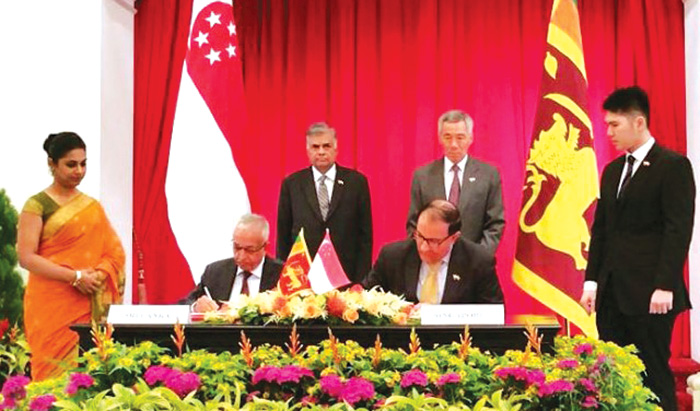
Sri Lanka-Singapore Free Trade Agreement
By Gomi Senadhira
senadhiragomi@gmail.com
“You might tell fairy tales, but the progress of a country cannot be achieved through such narratives. A country cannot be developed by making false promises. The country moved backward because of the electoral promises made by political parties throughout time. We have witnessed that the ultimate result of this is the country becoming bankrupt. Unfortunately, many segments of the population have not come to realize this yet.” – President Ranil Wickremesinghe, 2024 Budget speech
Any Sri Lankan would agree with the above words of President Wickremesinghe on the false promises our politicians and officials make and the fairy tales they narrate which bankrupted this country. So, to understand this, let’s look at one such fairy tale with lots of false promises; Ranil Wickremesinghe’s greatest achievement in the area of international trade and investment promotion during the Yahapalana period, Sri Lanka-Singapore Free Trade Agreement (SLSFTA).
It is appropriate and timely to do it now as Finance Minister Wickremesinghe has just presented to parliament a bill on the National Policy on Economic Transformation which includes the establishment of an Office for International Trade and the Sri Lanka Institute of Economics and International Trade.
Was SLSFTA a “Cleverly negotiated Free Trade Agreement” as stated by the (former) Minister of Development Strategies and International Trade Malik Samarawickrama during the Parliamentary Debate on the SLSFTA in July 2018, or a colossal blunder covered up with lies, false promises, and fairy tales? After SLSFTA was signed there were a number of fairy tales published on this agreement by the Ministry of Development Strategies and International, Institute of Policy Studies, and others.
However, for this article, I would like to limit my comments to the speech by Minister Samarawickrama during the Parliamentary Debate, and the two most important areas in the agreement which were covered up with lies, fairy tales, and false promises, namely: revenue loss for Sri Lanka and Investment from Singapore. On the other important area, “Waste products dumping” I do not want to comment here as I have written extensively on the issue.
1. The revenue loss
During the Parliamentary Debate in July 2018, Minister Samarawickrama stated “…. let me reiterate that this FTA with Singapore has been very cleverly negotiated by us…. The liberalisation programme under this FTA has been carefully designed to have the least impact on domestic industry and revenue collection. We have included all revenue sensitive items in the negative list of items which will not be subject to removal of tariff. Therefore, 97.8% revenue from Customs duty is protected. Our tariff liberalisation will take place over a period of 12-15 years! In fact, the revenue earned through tariffs on goods imported from Singapore last year was Rs. 35 billion.
The revenue loss for over the next 15 years due to the FTA is only Rs. 733 million– which when annualised, on average, is just Rs. 51 million. That is just 0.14% per year! So anyone who claims the Singapore FTA causes revenue loss to the Government cannot do basic arithmetic! Mr. Speaker, in conclusion, I call on my fellow members of this House – don’t mislead the public with baseless criticism that is not grounded in facts. Don’t look at petty politics and use these issues for your own political survival.”
I was surprised to read the minister’s speech because an article published in January 2018 in “The Straits Times“, based on information released by the Singaporean Negotiators stated, “…. With the FTA, tariff savings for Singapore exports are estimated to hit $10 million annually“.
As the annual tariff savings (that is the revenue loss for Sri Lanka) calculated by the Singaporean Negotiators, Singaporean $ 10 million (Sri Lankan rupees 1,200 million in 2018) was way above the rupees’ 733 million revenue loss for 15 years estimated by the Sri Lankan negotiators, it was clear to any observer that one of the parties to the agreement had not done the basic arithmetic!
Six years later, according to a report published by “The Morning” newspaper, speaking at the Committee on Public Finance (COPF) on 7th May 2024, Mr Samarawickrama’s chief trade negotiator K.J. Weerasinghehad had admitted “…. that forecasted revenue loss for the Government of Sri Lanka through the Singapore FTA is Rs. 450 million in 2023 and Rs. 1.3 billion in 2024.”
If these numbers are correct, as tariff liberalisation under the SLSFTA has just started, we will pass Rs 2 billion very soon. Then, the question is how Sri Lanka’s trade negotiators made such a colossal blunder. Didn’t they do their basic arithmetic? If they didn’t know how to do basic arithmetic they should have at least done their basic readings. For example, the headline of the article published in The Straits Times in January 2018 was “Singapore, Sri Lanka sign FTA, annual savings of $10m expected”.
Anyway, as Sri Lanka’s chief negotiator reiterated at the COPF meeting that “…. since 99% of the tariffs in Singapore have zero rates of duty, Sri Lanka has agreed on 80% tariff liberalisation over a period of 15 years while expecting Singapore investments to address the imbalance in trade,” let’s turn towards investment.
Investment from Singapore
In July 2018, speaking during the Parliamentary Debate on the FTA this is what Minister Malik Samarawickrama stated on investment from Singapore, “Already, thanks to this FTA, in just the past two-and-a-half months since the agreement came into effect we have received a proposal from Singapore for investment amounting to $ 14.8 billion in an oil refinery for export of petroleum products. In addition, we have proposals for a steel manufacturing plant for exports ($ 1 billion investment), flour milling plant ($ 50 million), sugar refinery ($ 200 million). This adds up to more than $ 16.05 billion in the pipeline on these projects alone.
And all of these projects will create thousands of more jobs for our people. In principle approval has already been granted by the BOI and the investors are awaiting the release of land the environmental approvals to commence the project.
I request the Opposition and those with vested interests to change their narrow-minded thinking and join us to develop our country. We must always look at what is best for the whole community, not just the few who may oppose. We owe it to our people to courageously take decisions that will change their lives for the better.”
According to the media report I quoted earlier, speaking at the Committee on Public Finance (COPF) Chief Negotiator Weerasinghe has admitted that Sri Lanka was not happy with overall Singapore investments that have come in the past few years in return for the trade liberalisation under the Singapore-Sri Lanka Free Trade Agreement. He has added that between 2021 and 2023 the total investment from Singapore had been around $162 million!
What happened to those projects worth $16 billion negotiated, thanks to the SLSFTA, in just the two-and-a-half months after the agreement came into effect and approved by the BOI? I do not know about the steel manufacturing plant for exports ($ 1 billion investment), flour milling plant ($ 50 million) and sugar refinery ($ 200 million).
However, story of the multibillion-dollar investment in the Petroleum Refinery unfolded in a manner that would qualify it as the best fairy tale with false promises presented by our politicians and the officials, prior to 2019 elections.
Though many Sri Lankans got to know, through the media which repeatedly highlighted a plethora of issues surrounding the project and the questionable credentials of the Singaporean investor, the construction work on the Mirrijiwela Oil Refinery along with the cement factory began on the24th of March 2019 with a bang and Minister Ranil Wickremesinghe and his ministers along with the foreign and local dignitaries laid the foundation stones.
That was few months before the 2019 Presidential elections. Inaugurating the construction work Prime Minister Ranil Wickremesinghe said the projects will create thousands of job opportunities in the area and surrounding districts.
The oil refinery, which was to be built over 200 acres of land, with the capacity to refine 200,000 barrels of crude oil per day, was to generate US$7 billion of exports and create 1,500 direct and 3,000 indirect jobs. The construction of the refinery was to be completed in 44 months. Four years later, in August 2023 the Cabinet of Ministers approved the proposal presented by President Ranil Wickremesinghe to cancel the agreement with the investors of the refinery as the project has not been implemented! Can they explain to the country how much money was wasted to produce that fairy tale?
It is obvious that the President, ministers, and officials had made huge blunders and had deliberately misled the public and the parliament on the revenue loss and potential investment from SLSFTA with fairy tales and false promises.
As the president himself said, a country cannot be developed by making false promises or with fairy tales and these false promises and fairy tales had bankrupted the country. “Unfortunately, many segments of the population have not come to realize this yet”.
(The writer, a specialist and an activist on trade and development issues . )

